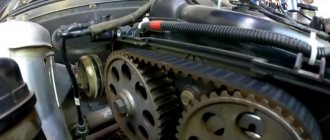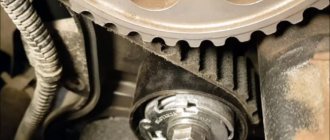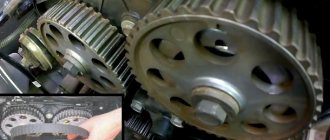Why do LADA owners care about the frequency of replacing the timing belt (gas distribution mechanism) on their cars? Mainly due to the consequences of a broken belt, in some cases the valve bends, which ends in expensive repairs. Let's figure out at what mileage the manufacturer recommends changing the timing belt and rollers, as well as what its actual service life is.
Largus engine line
Under the hood of the Togliatti station wagon, which in its maiden days was known in Europe as the Dacia Logan MCV, one of two powertrain options can currently be installed:
- 8-valve 11189 with a power of 87 hp. s., familiar to domestic car owners from Kalina and Grant;
- 16-valve French K4M with 102 hp. pp., produced by AvtoVAZ under license.
The 1.6-liter engines are equipped with an injection power system and comply with Euro-5 standards.
Unfortunately, the design of both engines is such that if the belt teeth break or are cut off, the valves of the gas distribution mechanism bend. Therefore, it is necessary to carry out preventive work on time to replace the timing drive of the Lada Largus.
Time frame for replacing the timing drive: according to regulations and real experience
Of course, you can rely on high-quality belt material and modern manufacturing technologies and carry out replacement according to regulations. However, the experience of Largus owners suggests that it is better to reduce this period by half. Otherwise, there is a high probability of an unexpected breakdown, and then you will have to use a tow truck to get to the nearest car service center.
So, based on the results of actual operation, taking into account Russian climatic conditions, it is recommended to replace the Lada Largus timing belt at intervals of 60 thousand kilometers.
Replacing the timing drive on an 8-valve Lada Largus
The procedure for replacing a belt on a Largus with an 8-valve VAZ engine is well known and does not cause any difficulties.
Removing the drive belt
First, the car is installed on an overpass or lift, the negative terminal is removed from the battery, and the front right wheel is dismantled:
- The crankshaft is rotated clockwise by the pulley mounting bolt to position the No. 1 cylinder piston at top dead center (TDC) of the compression stroke. The TDC position is determined by aligning the marks on the camshaft pulley and the rear cover of the timing mechanism.
- The camshaft and crankshaft are fixed in this position.
- Using a 10mm wrench, unscrew the three bolts holding the protective timing belt cover of the Lada Largus and remove it.
- The fastening screw is turned out and the generator belt pulley is removed.
- Using a 17 wrench, loosen the nut of the timing belt tension roller; the roller is rotated in such a way as to loosen the belt as much as possible. After this, the timing belt is removed from the crankshaft, pump, camshaft and roller pulleys, the nut is completely unscrewed, and the roller is dismantled.
Installing a new drive belt
The new belt is placed on the engine crankshaft pulley. Having tensioned both branches of the drive belt, we put the rear part of the timing belt on the toothed pulley of the water pump and then pass it through the tension roller. We install the front part of the belt on the camshaft pulley. The following steps follow:
- To tighten the timing belt, you need to turn the tension roller counterclockwise.
- We tighten the screw of the generator pulley and turn the crankshaft of the Lada Largus clockwise to a position at which the control marks of the crankshaft and camshaft coincide.
After installation is complete, screw on the drive belt protective cover.
Features of service provision
Before talking about the services we offer and their relevance, you should pay attention to the design features of the engines installed on this station wagon, its pseudo-off-road version and van. There are four in total
Initially, the model, which is essentially a modernized version of the Dacia/Renault Logan MCV of the first generation, was equipped with engines installed on Renault Largus cars. It received K4M and K7M gasoline engines, both in-line “fours”, the first has 16 valves, the second has 8 valves. A further development of the model was the installation of motors of our own production, adapted for French gearboxes. The K7M engine was replaced by the VAZ 11189 (a slightly modified version of the VAZ 11186); this power unit is not found anywhere else on other Togliatti-assembled models. The K4M was replaced in 2022 by the VAZ 21129 (a modernized version of the VAZ 21127 brought into compliance with Euro5 environmental standards), this engine is also installed on the Lada Vesta and Lada X-Ray
There are four of them in total. Initially, the model, which is essentially a modernized version of the Dacia/Renault Logan MCV of the first generation, was equipped with engines installed on Renault Largus cars. It received K4M and K7M gasoline engines, both in-line “fours”, the first has 16 valves, the second has 8 valves. A further development of the model was the installation of motors of our own production, adapted for French gearboxes. The K7M engine was replaced by the VAZ 11189 (a slightly modified version of the VAZ 11186); this power unit is not found anywhere else on other Togliatti-assembled models. The K4M was replaced in 2022 by the VAZ 21129 (a modernized version of the VAZ 21127 brought into compliance with Euro5 environmental standards), this engine is also installed on the Lada Vesta and Lada X-Ray.
On the timing belt of all Lada Largus engines there is a belt, or rather a timing belt of the Lada Largus, there are toothed pulleys for the crankshaft, camshaft (if there are 16 valves, then there are two pulleys, according to the number of camshafts, that is, one pulley for the intake camshaft, the second for the exhaust), water pump . A Largus timing tension roller is also used (if there are 16 valves, then the tension roller tensions the belt, and a second Largus timing support roller is also used).
Our specialists carry out both replacement of the timing belt for 16 Largus valves and replacement of the timing belt for Largus 8 valves.
In addition to the timing belt, the Lada Largus uses a belt that drives auxiliary units. This is the so-called Lada Largus generator belt or the second name is the Largus drive belt. We replace the Largus drive belt. The specifics depend directly on the design of the drive that ensures the operation of the auxiliary units, or more precisely, the configuration of the car. A number of configurations are “empty”. This is the simplest diagram, there are two pulleys, one for the generator, the other for the crankshaft, between them is the Lada Largus generator belt. In this case, we offer such type of work as replacing the Lada Largus belt.
The second scheme is a little more complicated. A number of trim levels include the installation of power steering (power steering). Then a power steering pump pulley and a belt tensioning roller (it’s called a tensioner) are additionally installed. This Largus drive belt differs from the generator belt, it is longer. In other words, a diagram with three pulleys and one roller.
Our craftsmen are replacing the Largus drive belt.
The richest trim levels come with not only power steering, but also air conditioning. In this case, an additional drive pulley for the air conditioning compressor and a bypass pulley for the belt, that is, four pulleys, two rollers and a Lada Largus air conditioning belt.
We replace the Largus air conditioner belt, and also offer to purchase the Lada Largus spare parts necessary to provide this type of service.
Which timing belt to choose for Lada Largus
In addition to the correct procedure for replacing the drive belt, the quality of the parts purchased has a significant impact on its service life.
For an 8-valve engine, the choice of timing belts is quite varied. AvtoVAZ is considered the official supplier.
Among the substitutes were products from companies such as Bosch, Pilenga, Dayco, SKF and a number of others. Reviews from owners about the actual characteristics of products from various manufacturers are quite contradictory, so for cars under warranty you should follow the recommendations of official dealers, and in other cases rely on your own experience.
16-valve Lada Largus engines in the original configuration are equipped with a belt 117206842R GATES 6 RK 1822, the cost of which is an order of magnitude higher than that of its 8-valve counterpart. The replacement kit includes the drive belt itself, a tensioner and a idler pulley.
Answers (2)
The timing belt and rollers in engines of this model are replaced at 120 thousand km (after 6 years of operation). However, we recommend that you inspect the condition of the timing belt and rollers once a year, because during operation, oil or dirt may get on the belt, in which case the belt must be urgently replaced.
They write differently, who to believe, the answers vary from 120,000 in the service book to 60,000 they say at the Renault service station, I changed it at 75,664 km at the Renault service station, my removed belt was like new, no cracks or stripes anywhere, but what kind of videos? In general, reluctantly from the money spent, I changed it because... There were long routes ahead, and a new one is a new one.
Not so long ago, the Largus station wagon from the Tolyatti company Lada, which appeared on the Russian market, managed to acquire high demand, so many owners of this model are interested in the question of how and when to change the timing belt.
Preparatory work
If you forgot when you changed the timing belt on the Largus (16 valves), it’s better to carry out the repair. If you do not want to make the replacement yourself, contact a service station. To repair on your own, you will need to do the following preparatory work:
- Disconnect the negative wire from the battery. This will ensure that your vehicle is fully powered.
- Disconnect the inlet pipe, and then remove the drive belt of the generator and other auxiliary mechanisms.
- The support on the right side of the engine will interfere with you, so it must be removed.
- The protection cover consists of lower and upper halves. They must be removed by unscrewing the mounting bolts.
That's all, the preparatory work is finished. You can begin replacing the timing belt on the Largus (16 valves).
Power units Largus
In fact, Largus is a “clone” of the popular Dacia Logan MCV in France, so the manufacturer provided for this model not only an 87-horsepower 8-valve “four” (series “11189”), but also a French unit with 16 valves - K4M, with a power 102 hp
ATTENTION! A completely simple way to reduce fuel consumption has been found! Don't believe me? An auto mechanic with 15 years of experience also didn’t believe it until he tried it. And now he saves 35,000 rubles a year on gasoline! Read more"
Among the design features of the first installations, it is worth noting the risk of valve bending when the timing belt drive breaks, which forces Largus owners not to put off replacing the belt “for later” and to do it when the slightest signs of wear appear.
Failure of the timing belt on a 16-valve engine will also lead to valves meeting the pistons - due to a mismatch in the rotation angles of the crankshaft and camshafts, which will result in expensive repairs of the internal combustion engine.
16 valve engines
The basis for this station wagon was the Dacia Logan MCV from Renault. Initially, two power units with a working volume of 1600 cm 3 K7M, K4M of this company were installed in Largus. In 2015, the K7M was replaced by the VAZ 11189 with eight valves in the cylinder head, and in 2022 the VAZ 21129 appeared. This engine already has 16 valves in the cylinder head; a little later it began to be installed on Vesta, Lada XRAY.
After mastering the production of this power unit, the automobile plant abandoned the use of engines produced by the Renault-Nissan concern. The car's transmission remained from Renault, but with significant modifications for operating conditions in the regions of Russia and other CIS countries.
K4M
The power unit of this modification is available only on a seven-seater station wagon or on cars with the “Lux” package. The engine displacement is 1600 cm3, 16 valves are installed in the cylinder head. Its power is 102 horsepower with a compression ratio of 9.5. Average fuel consumption is within 7.9 liters per hundred kilometers. Experts and car owners note that the noise of the running engine is reduced, vibration in all modes of its operation is completely eliminated.
As a disadvantage, insufficiently high dynamic performance of the engine and the occurrence of misfires when operating on fuel of dubious quality are noted. The complex design of the engine affects the conditions of its assembly, and this slightly increases the cost of the engine, and therefore the cost of servicing this unit increases compared to engines with 8 valves in the cylinder head. Manufacturers promise a resource for the engine of at least 450 thousand kilometers, or even more, if it is maintained correctly and in a timely manner.
VAZ-21129
This engine also has a displacement of 1600 cm 3, 16 valves in the timing drive. Its power was increased slightly, it became equal to 106 hp. With. Structurally, it is not too different from most serial VAZ engines. Cast iron cylinder block, their in-line arrangement, toothed belt in the timing mechanism drive. Hydraulic compensators are not installed. It has become more reliable and less critical of the composition of the fuel used.
The gearbox is mechanical, it remained from the Frenchman, but with significant modifications to adapt it to operating conditions in the regions of the Russian Federation. In the gearbox, the gear ratios for third, fourth, and fifth gears have been changed. This allowed the car to move at lower engine speeds, acoustic noise decreased, and gasoline consumption decreased. Average fuel consumption did not go beyond 7.9 liters per hundred kilometers.
Timing for replacing the timing belt on Lada Largus
Important! For all types of engines installed on the Lada Largus, the manual instructs the owner to replace the timing belt after a mileage of 120 thousand km or after 6 years of operation.
Inexperienced car owners rely on high-quality materials for the timing belt, but in practice this is not confirmed and it is better to replace the belt drive approximately half before the scheduled time, which helps prevent the risk of sudden belt breakage and complete engine failure.
What else should I do when replacing the timing belt?
If you decide to replace the timing belt on a 16-valve engine, it is advisable to check the condition of all system components to ensure they are in good condition. If there are extraneous sounds when the engine is running, this is clearly a symptom that the timing belt and rollers need to be replaced. These components are changed in any case, but the pump and pulleys have a slightly longer service life. In particular, pulleys can last at least 120 thousand km, and this is a considerable mileage. But usually they “walk” much longer.
Replacing a belt drive on an 8-valve Lada Largus
Replacing the timing belt on 8-valve engines is a fairly well-known procedure and today it is unlikely to cause any difficulties. You can do this yourself. Of course, before installing a new belt, you must remove the old one.
Installation of a new timing belt on a Lada Largus with an 8-valve internal combustion engine is carried out as follows.
- First, the new belt must be placed on the crankshaft pulley.
- Next, tensioning the belt “by hand”, you need to hang it on the toothed pulley of the cooling circuit pump.
- Afterwards, the belt is hung on the camshaft pulley and wound behind the tension roller.
Replacing the timing belt in the 16-valve version of Lada Largus
The preparatory process for replacing a belt drive on a 16-valve internal combustion engine is almost similar to the previously discussed procedure with an 8-valve “four”.
- After hanging and de-energizing the car, we dismantle the engine crankcase protection.
- We install a suitable support under the engine and dismantle the right support using a key set to “19”.
- Next, you need to remove both timing protection covers and then block the crankshaft.
- Afterwards, using a key set to “18”, remove the auxiliary drive pulley.
- Before removing the belt itself, it is necessary to set the piston of the first cylinder to the TDC position. To do this, rotate the crankshaft by its pulley bolt.
Attention! The K4M engine, like the K7M unit, has cylinder numbering from the flywheel, and not from the timing drive unit.
- Before removing the old belt, it is necessary to determine the position in which the camshafts are located.
- Afterwards, remove the intake resonator and remove the plugs from the openings on the left end of the cylinder head.
- By rotating the crankshaft, it is necessary to reach the position of the camshafts when their marks on the ends of the gears coincide with the upper plane of the head surface, after which the marked shafts should be immobilized.
- To check the correct position of the crankshaft, we resort to using the hole under the oil pressure sensor.
- After unscrewing the plug, screw an M10 control bolt with a thread length of 75 mm into the hole. If the crankshaft is in the correct position, the bolt is screwed in completely.
- Now we loosen the belt tension and the tension roller mounting nut using a “13” wrench. Mechanical tension in the belt is relieved by turning the roller counterclockwise.
Installation of a new belt drive is carried out using the reverse removal algorithm. The roller paired with the tension mechanism is replaced with new analogues. When attaching a belt, you should use the hints in the form of arrows marked on the product.
The correct position of the shaft must be checked by screwing in the control bolt. If everything is correct, do not forget to close the hole with a plug.
Snapshot53252323
Marking of the drive belt for auxiliary units 6РК 995 (six-V-ribbed, length - 995 mm).
Marking of the drive belt for auxiliary units 6РК 995 (six-V-ribbed, length - 995 mm). In order to improve visual control, remove the plastic engine casing. To check the condition of the belt, engage fifth gear in a manual transmission, push the car (or rotate the suspended wheel) and inspect the belt along its entire length. On a car with an automatic transmission, remove the right mudguard of the engine compartment and, by rotating the crankshaft by the bolt of the auxiliary drive pulley, check the condition of the belt.
With any of the gearboxes, the following method is also possible: apply chalk marks to sections of the belt and, turning on the starter for short periods of time, turn the crankshaft at small angles. We inspect the belt along its entire length, checking the areas covered by the marks.
The belt should not have cracks, tears or separation of rubber from the fabric base. A defective belt must be replaced. To do this, from the engine compartment side...
Prices and articles, originals and analogues of belts for Lada Largus
For 8-valve versions of Lada Largus, manufacturers offer a wide range of options. The article number of the original timing belt kit from Renault for the 8-valve K7M engine is 130C17480R. The kit includes a tension roller. The price tag starts from 2,500 rubles.
Gates has long been the official supplier of components for VAZ cars. As analogues, you can also choose belts from the brands Bosch, Dayco, SKF, etc.
If a Largus with a 16-valve engine is still under warranty, then the most correct solution would be to install a timing belt kit with catalog number - 117206842R GATES 6 RK 1822. The price for it starts from 4,300 rubles, which is significantly higher than the cost of the belt used in Timing belt variations Largus with an internal combustion engine with 8 valves.
The cost of the timing belt itself, manufactured by Renault, for both the K7M and K4M engines starts from 800 rubles. Price lists for taxes can be found below.
What should you choose? The only thing that can be recommended is to purchase a belt as a set, the original one - Renault, or from Gates.
Replacing the timing belt is absolutely not a complicated procedure, so you should not skimp on such an important consumable component for the engine. A couple of thousand rubles are completely incommensurate with the financial losses in the event of a timing belt drive breakage.










